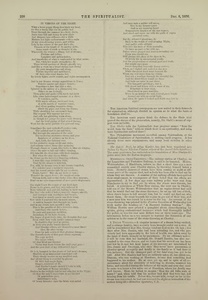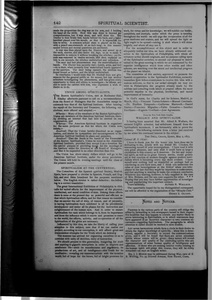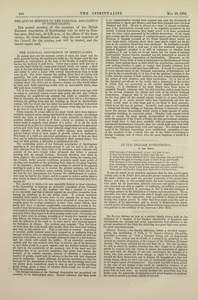Egyptian Priority
Can the theologian derive no light from the pure primeval 'faith that glimmers from Egyptian heroglyphics to illustrate the immortality of the soul? Will not the historian deign to notice the prior origin of every art and science in Egypt, a thousand years before the Pelasgians studded the isles and capes of the Archipelago with their forts and temples?—long before Etruscan civilization had smiled under Italian skies? And shall not the ethnographer, versed in Egyptian lore, proclaim the fact that the physiological, craniological, capillary, and cuticular distinctions of the human race existed on the first distribution of mankind throughout the earth?
“Philologists, astronomers, chemists, painters, architects, physicians, must return to Egypt to learn the origin of language and writing; of the calendar and solar motion; of the art of cutting granite with a copper chisel, and of giving elasticity to a copper sword; of making glass with the variegated hues of the rainbow; of moving single blocks of polished syenite, nine hundred tons in weight, for any distance, by land and water; of building arches, round and pointed, with masonic precision, unsurpassed at the present day, and antecedent by two thousand years to the ‘Cloaca Magna’ of Rome; of sculpturing a Doric column one thousand years before the Dorians are known in history; of fresco painting in imperishable colors; of practical knowledge in anatomy; and of time-defying pyramid building.
“Every craftsman can behold, in Egyptian monuments, the progress of his art four thousand years ago; and whether it be a wheelwright building a chariot, a shoemaker drawing his twine, a leather-cutter using the selfsame form of knife of old as is considered the best form now, a weaver throwing the same hand-shuttle, a whitesmith using that identical form of blowpipe but lately recognized to be the most efficient, the seal-engraver cutting, in hieroglyphics, such names as Shoop- ho's, above four thousand three hundred years ago,— all these, and many more astounding evidences of Egyptian priority, now require but a glance at the plates of Rossellini.”
The Sleeping Congregation – Hogarth
A Dream Verified
A Dream Verified.—A singular instance of a dream being verified, and a strange fatality, have recently been brought under our notice. It will be remembered that Mrs. George Lindsay died on the 5th inst.; five days after Mrs. Rankin, who had been attending her, and who previously had been apparently in the best of health, was taken away by the hand of death, brought on by pneumonia. By an oblituary notice, it will be seen that her husband, Mr. Donald Rankin, has also succumbed to the same disease, and we learn that his second son has been laid low by it, and but faint hopes of. his recovery are entertained by Drs. James and Sweetnan, who state they never knew pneumonia or pleurisy spread so rapidly and fatally in one family as it had done in this instance. But the strangest part of the fatal story has yet to be told. After Mrs. Rankin had been so suddenly taken ill, her eldest son, Duncan, who was working at Horsham, dreamt that something had happened to his mother. He at once got up, and in Spite of all remonstrance about the absurdity of believing in dreams, mounted his horse, and travelled during the balance of-the night and next day, until he came to a house a few miles out of Hamilton, where his family was well known. Here he halted to inquire “How the old folks were at homo? and, when told that his mother had died that very day, fell fainting from his saddle. Before this, we are told, except so far as the dream was concerned, he had not received the slightest intimation of his mother being ill.—Hamilton Spectator, U.S.
Wallace and Spiritualism
It having been asserted that Mr. Alfred R. Wallace, the eminent English scientist, had withdrawn himself from the Spiritualistic movement, I am fortunately able to prove the contrary. The following extracts from a letter just received by me attest his continued interest in the subject:
The Dell, Grays, Essex, May 2, 1875.
Colonel H.S. Olcott:
I have to thank you for the honor you have done me in dedicating to me, jointly with my friend Mr. Crookes, the interesting record of your investigations. I have read it with very great pleasure, and only wish it could have as large a circulation in this country as it deserves. Its fair and impartial spirit, as well as its great literary merits, would greatly aid in that reaction of modern thought against modern materialism which is becoming every day more evident. I have myself seen nothing half so wonderful or perhaps half so convincing as you have seen, and 1 think you under-rate the value of your investigations at the Eddys’ when you infer almost to the last that they might be imposters to some extent, and that anything is wanting to make the evidence conclusive. Whatever was wanting, however, is fully supplied in the case of Mrs. Holmes, and the one case supports the other. *** Hoping that you may have further opportunities of investigating and popularizing this important subject.
Yours faithfully,
The opportunity hoped for by my distinguished correspondent will be afforded in the organization of the “Miracle Club.”
Modern Theism
Modern Theism.— On Sunday afternoon, before a crowded congregation, the Archbishop of York, in St. James’s Church, Piccadilly, preached a sermon on “God, a Personal Being, not an Impersonal Force.” The sermon was the fourth of a series to be preached at the church by eminent clergymen, at the request of the Christian Evidence Society. His Grace selected for his text Heb. iii. 4. The one question, he said, to which he invited attention was this: Ought we to allow our minds to connect with the beauty of nature, the symmetry of nature’s laws, and with the dictates of our own consciences, the thought of a Being who had caused all those things, or ought we to see nothing beyond the facts themselves, and to dismiss all thoughts of a wise and loving Being, whom we have not seen as unscientific, and as belonging to the vague region of metaphysics? The world was full of facts, which in the case of any human works would be conclusive evidence of an intelligent maker, and the mind hastened to the conclusion that Intelligence was at work here. As nobody doubted the possibility that God might exist, the generality of mankind would never hesitate to attribute the work of creation to God.—Daily Telegraph.
Editor's notes
- ↑ Egyptian Priority by unknown author, Spiritual Scientist, v. 3, No. 14, December 9, 1875, p. 159
- ↑ The Sleeping Congregation – Hogarth by unknown author
- ↑ A Dream Verified by Spectator, Hamilton, London Spiritualist, No. 224, December 8, 1876, p. 228
- ↑ Wallace and Spiritualism by Olcott, H. S., Spiritual Scientist, v. 2, No. 12, May 27, 1875, p. 142
- ↑ Modern Theism by unknown author, London Spiritualist, No. 195, May 19, 1876, p. 240. Daily Telegraph





